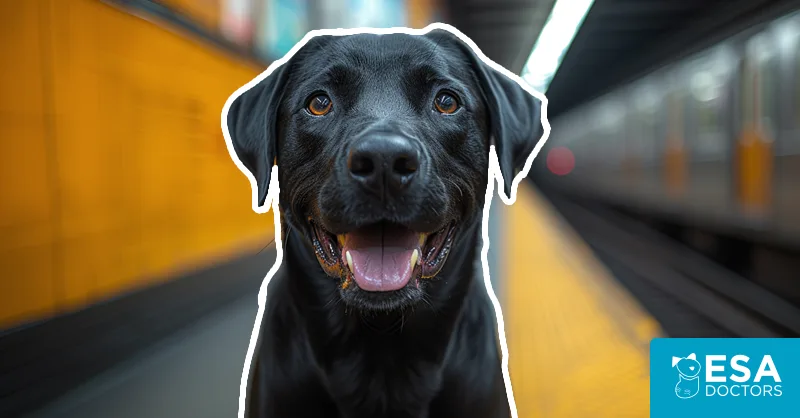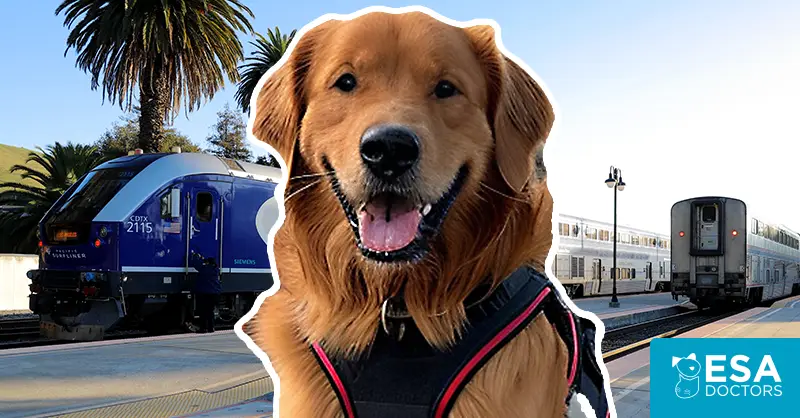Navigating the bustling underground world of the New York City subway with your dog can be both an exciting and daunting prospect. With over 5.5 million riders daily, the subway is the city’s lifeline, pulsing through the five boroughs.
For dog owners, it presents a unique set of challenges. This article aims to provide you with a comprehensive guide on how to make your subway journey with your dog or service dog as smooth and stress-free as possible.
- Understanding the MTA’s Rules for Dogs
- Service Dogs on the Subway
- Pre-Trip Preparations
- On the Platform
- Boarding the Train
- During the Journey
- Exiting the Train
Understanding the MTA’s Rules for Dogs
First and foremost, it’s crucial to understand the Metropolitan Transportation Authority’s (MTA) rules regarding dogs on the subway. The MTA allows dogs on the subway as long as they are “enclosed in a container and carried in a manner which would not annoy other passengers.”
This policy means your dog should be in a pet carrier or bag. There is no specific size limit for the container as long as you can carry it without blocking the subway aisles or seats. A common sight in New York is large dogs in blue Ikea bags or large tote bags on the shoulders of their faithful owners.
Service Dogs on the Subway
Service dogs are an exception to the container rule. Under the Americans with Disabilities Act (ADA), service dogs (including psychiatric service dogs) are allowed to accompany their owners anywhere the general public is permitted, including subway cars and station platforms. They do not need to be in a carrier, but they should be leashed and under control at all times.
The New York MTA also has a unique program for a Service Animal Identification card. This program is voluntary – you never need an ID card to get service dog rights. However, the ID card can be useful for service dog handlers who prefer not to answer questions from MTA staff about their service dog.
The MTA NYC Transit promotes the use of these ID cards to avoid misunderstandings between their personnel and passengers with disabilities as to whether the dog they are traveling with is a true service animal.
The application does, however, have some onerous documentation requirements that are unusual for service dog owners. Among other things, the application requires a letter from a physician and a letter verifying your disability from one of these organizations:
- Social Security Administration Social Security Administration
- Office of Vocational and Educational Services for Individuals with Disabilities (VESID)
- Commission for the Blind and Visually Handicapped (CBVH)
- Other Federal/State recognized agency for people with disabilities
It’s important to reiterate that this ID card, like all service dog ID cards, is entirely optional. Service dog owners never need to present an ID card to be accommodated.
If you’re approached by the NYPD or MTA staff, they can verify your service dog by asking two questions: 1. Is the dog a service dog required for a disability? and 2. What work or task has the dog been trained to perform?
Under the ADA, they do not have the right to insist upon seeing an ID card or other documentation.
Pre-Trip Preparations
Acclimating Your Dog: Before attempting a subway ride, ensure your dog is comfortable with crowded, noisy environments. New York trains can be especially noisy – the trains themselves can emit loud screeches.
Train stations are also bustling, with rushing commuters, buskers, and vendors. New Yorkers know that the subway can be full of surprises. Make sure your service dog won’t be startled or led astray from its job by all of these distractions.
Choosing the Right Carrier: If your dog isn’t a service animal, select a comfortable and secure carrier. It should be spacious enough for your dog to sit, stand, and turn around but compact enough to carry easily. Many New Yorkers utilize tote bags and Ikea bags for this purpose.
Identification and Microchipping: Ensure your dog has a collar with an ID tag and is microchipped. In the rare case your dog gets lost, this will help with a quick reunion.
Packing Essentials: Bring water, a collapsible bowl, dog treats, a favorite toy, waste bags, and a small blanket or towel.
On the Platform
Safety First: Keep your dog leashed or in its carrier while waiting for the train. There can be a lot of traffic on the train, so if your dog is a service dog, keep your leash as short as possible to avoid people tripping over it. Stay away from the platform edge and be cautious of the gap between the train and the platform.
Unfortunately, there are many instances of trains hitting people waiting on platforms, so you should keep some distance from the tracks while with your dog. Subway platforms are also full of people rushing around who might not see your dog and inadvertently run into your dog or your leash. It’s important to be fully mindful of your surroundings on subway platforms.
Managing Anxiety: The noise of an approaching train can be startling. Comfort your dog by staying calm and offering treats or their favorite toy.

Boarding the Train
Choosing the Right Car: Opt for a less crowded car, usually found towards the end of the train. Avoid rush hours if possible.
Securing Your Spot: Once aboard, find a space where your dog won’t obstruct the aisle. If your dog is in a carrier, place it securely on the floor by your feet. If the train is standing room only, be mindful about blocking the train doors.
Dealing with Crowds: If the train is crowded, stay calm and assertive. Use your body to create a small barrier around your dog to prevent accidental stepping or bumping.
During the Journey
Monitoring Your Dog: Keep an eye on your dog for signs of stress or discomfort. Offer reassurance and treats to keep them calm.
Managing Noise and Motion: The subway can be loud and jerky. Comfort your dog by speaking to them in a soothing voice and petting them, if possible.
Managing People: New Yorkers love dogs! There’s a good chance they’ll want to pet and play with your dog. Remember that it’s okay for you to set boundaries, and strangers should not touch your dog without permission first. If your dog is a service dog, consider getting a vest or service dog tags so people know your dog is on duty.
Exiting the Train
Prepare in Advance: As your stop approaches, get ready to exit by gathering your belongings and preparing your dog.
Exiting Safely: Wait for the train to come to a complete stop before exiting. Watch the gap between the train and the platform.
Ensuring a Tail-Wagging Subway Experience
Taking your dog on the NYC subway can be a seamless experience with the proper preparation and mindfulness. Understanding and adhering to MTA rules, preparing adequately, and being considerate of your dog and fellow passengers can ensure a pleasant journey for everyone involved.
Need a PSD letter from a licensed therapist?
See if you have a qualifying disorder for a PSD in 3 easy steps.




Dog owner here. The subway is no place for dogs! It’s scary snd noisy enough for people.
And some people and children are allergic and afraid of dogs.
Unfortunately some dog owners are as bad as fare beaters, the rules dont apply to them. Very inconsiderate, I no longer take the train.
We respectfully have to disagree. We know many dog owners and service dog owners that frequently take the subway without any issues. They are a fairly common sight these days in a city filled with dog lovers. In addition, service dog owners do not have a choice – they need their service dogs by their side to help cope with physical and mental health disabilities.